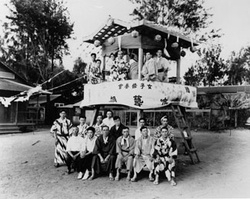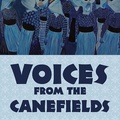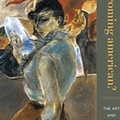Obon is an annual Japanese Buddhist festival that commemorates the dead. It is based on a Buddhist text which describes how a devout monk dances with joy upon successfully releasing his deceased mother’s spirit from the Realm of Hungry Ghosts. Today, participants dance to express their joy to be living happily and to honor loved ones who have passed away. Obon is also commonly known as the Festival of Lanterns, referring to the traditional lighting of the chochin (lanterns) at family shrines and gravesites.
Obon is held outdoors during the summer months—in the street or in temple parking lots and courtyards. Central to its celebration among Japanese Americans are the folk dances (Bon Odori) performed to music that includes the steady beat of a taiko. The taiko sits on a raised platform, or a yagura, and musicians use bachi, or drumsticks, on the taiko, to keep time for the Bon odori dancers. The guiding purpose of Bon Odori is to set aside the ego through unselfconscious dancing. Participation is customarily diverse—with young and old, formally trained and informally trained dancers, Japanese Americans and non-Japanese Americans.
Tracing its roots back to Japan, Bon Odori evolved out of the Odori Nembutsu, a popular Buddhist chant and dance from the late Heian (794 - 1185) and Kamakura (1185 - 1333) periods. By the 1600s, it became widespread and very popular in rural communities, providing a break from farm life. During the Meiji period (1868 – 1912), Bon Odori was banned, as it was thought to encourage immoral behavior, especially among the young. The ban was lifted during the Taisho period (1912 – 1926), and new songs and dances were created, combining Western instruments with traditional Japanese ones. In 1934, the song “Tokyo Ondo” became a hit.

Keahua Plantation Fukushima Ondo group, Hawai‘i, 1932 Gift of the Albert and Ayako Watanabe Family (97.251.12)
In the United States, the first mention of Bon Odori seems to have been in 1905, in the Yamato Shimbun newspaper in Hawaii. Reverend Yoshio Iwanaga is credited with introducing Bon Odori on the mainland in 1930—first while visiting the Stockton Buddhist Temple (where he met his future wife), as well as during temple visits in Washington, California, Oregon, and Canada. The first recorded Bon Odori was reportedly held at the San Francisco Temple in 1931. In Los Angeles, the first Bon Odori is said to have occurred in 1933 or 1934, on Central Avenue between First and Jackson Streets in Little Tokyo, at the Los Angeles Hompa Hongwanji Betsuin.
After the bombing of Pearl Harbor on December 7, 1941, Japanese Americans were incarcerated in camps. During this period many people emphasized their “American-ness,” but there was also a resurgence and maintenance of Japanese customs, and Buddhist communities in most camps organized Obon and Bon Odori. Following World War II, there was a surprisingly quick re-establishment of temple life, with Bon Odori resuming in Los Angeles in 1947. Rev. and Mrs. Iwanaga, who had been at Poston II, resettled in Watsonville, CA, where Rev. Iwanaga continued to teach Bon Odori at the local temple. Mrs. Iwanaga headed the BCA Music and Recording Department, which produced the first album of American Buddhist recordings of Gathas (Buddhist hymns set to Western-style music).
During the 1950s through the 1970s, Bon Odori became a traditional feature of Jodoshinshu temple Obon events, usually scheduled from late June through August. Dances were simplified, with a returned emphasis of Bon Odori as folk dances, with temple members now responsible for choosing and teaching the Bon Odori dances to their congregation. Bon Odori in the United States has a far stronger spiritual connection than it does in Japan today. Ironically, the Buddhist basis of Bon Odori is found almost exclusively in Jodoshinshu temples in the United States, and not in other sects of Buddhism, while the opposite is the case in Japan. TheJodoshinshu sect rejects the notion of “souls” returning at Obon, and thus, in Japan, Bon Odori is ignored. In the United States, the idea of souls being placated or welcomed is not connected with the idea of Obon in Japanese American Jodoshinshu temples.
Bon Odori emerged from the tradition of popular religious and folk music, with two styles of music: bushi, or folk songs, and ondo, folks songs influenced by the Goeika (religious chanting with bells). It was not until post-WWII that “ondo” was referenced to street dancing among some Japanese Americans. The song, “Bon Odori,” which is the first and last dance at most Bon Odoris, was written in 1934 by the Buddhist Music Association of the Honzan (mother temple) in Kyoto. The combination of folk melodies and dances form different types of Bon Odori, usually accompanied by instruments such as hand clapping, taiko (drum), atarigane, fue (flute), binsawa (wood rattle), and shamisen. Most dancers can be seen wearing a yukata, a lightweight, summer kimono, or a happi coat, a short kimono-like jacket.
While associated with Buddhism, Obon is celebrated and embraced by all, regardless of one’s religious background. Buddhist temples schedule their Obon events over the weekends from late June through August. These festivals are well attended, drawing large multi-generational and multi-racial crowds. Each temple’s festival is unique, but most generally feature carnival games with food booths serving traditional Japanese and Japanese American fare—sushi, udon, dango, teriyaki—as well as local cultural favorites, such as tacos and tamales in many Southern California celebrations.
* This article was originally published on Japanese American National Museum Store Online.
© 2006 Japanese American National Museum







